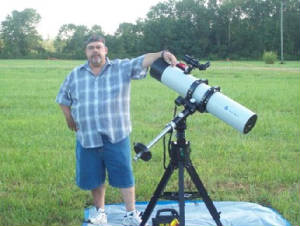|
|
GOB Star Party Report Lacy Thomas The third annual Penn’s Store (www.PennsStore.com) starparty was held Saturday night (Sept. 12, 2009) in the large field in front of the store. The stargazing was the closing activity of the 17th annual Great Outhouse Blowout (details on the website.) Lacy and Brenda Thomas (Elizabethtown, KY) were joined by Patrick Peak (Louisville, KY) to share the lovely autumn evening sky with the participants. However, the actual “stargazing” started early thanks to Pat, who set up his Coronado SolarMax 90mm hydrogen alpha solar telescope so folks could view our nearest star – and the Sun cooperated magnificently, displaying several decent prominences around its perimeter.
For the evening observing, Pat set up his superb Mak-Newt (6" f/6 Intes Maksutov-Newtonian telescope on a Losmandy GM8 German equatorial mount using Zeiss Abbe Orthoscopic II eyepieces-SWEET) while Lacy & Brenda set up two Dobs (an 8” Celestron and the renowned 14.5” Starmaster.) After a brief introduction, we toured the sky beginning from Polaris on to the Big Dipper, then arcing to Arcturus. We warped through Hercules to Vega, pointing out the Summer Triangle, and then followed the ‘steam’ of the Milky Way south to the teapot. We outlined the scorpion before steaming back north through Cygnus to Cassiopeia. Twenty-eight (28) attendees joined us, including ten eager younger viewers. These astronomers of tomorrow were not shy with their questions or their enthusiasm! We began with Jupiter but missed the pre-dusk Io transit. Most folks got to see the items below before we packed up around midnight. We handed out Skymaps, “Helpful Hints” (for getting started) and the following program.
M81 & M82, galaxies in Ursa Major. http://www.astropix.com/HTML/C_SPRING/M81_M82.HTM Antares – the Alpha star of Scorpio, “rival of Mars.” http://apod.nasa.gov/apod/ap980726.html M17 – Diffuse Nebula (the Swan nebula); Sagittarius. http://www.telescopes.cc/m17.htm M11 – open cluster, the “wild duck” cluster in Scutum. http://messier.obspm.fr/m/m011.html A globular cluster is a ‘glob’ or ball of stars whereas an open cluster is more ‘open.’ M13 – globular cluster in Hercules; http://www.concentric.net/~richmann/m13w.htm It is over 25,000 light years away and contains about 400,000 stars. M57 – Planetary Nebula (the Ring nebula); Lyra. http://www.maa.clell.de/Messier/E/m057.html Albireo – Double Star (the Michigan double) one blue, one gold. The “beak” of Cygnus, the swan! NGC7662 – Planetary Nebula (the Blue Snowball); small lavender blob. Andromeda. http://www.astroimages.org/ccd/ngc7662.html NGC457 – Open Cluster (E.T.), Cassiopeia. http://www.astrosurf.com/jwisn/ngc457.htm NGC884/869 – double Open Cluster, Perseus. http://www.astrosurf.com/lorenzi/images/hechi.htm M31 – Galaxy (the great Andromeda galaxy-our ‘sister’ galaxy!); Andromeda.
The only galaxy visible to the naked eye! ONLY 2.5 million light years away! http://www.astrocruise.com/galaxies/m31.htm (The official designations are listed in BOLD and the constellation where the item is located is underlined. Check weblinks for data and excellent pictures.)
|


